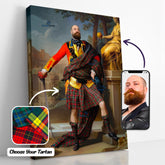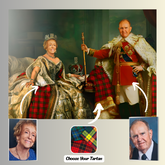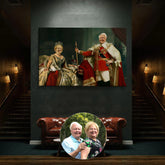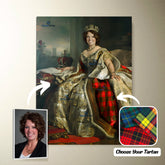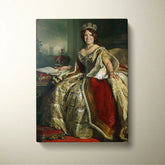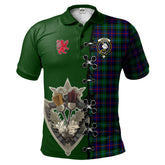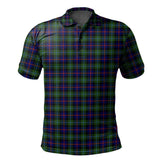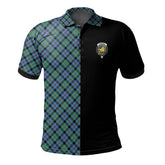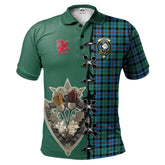-
Clan Campbell of Cawdor Tartan Polo Shirt - Royal Coat Of Arms Style KS23 - Campbell of Cawdor Tartan
Clan Campbell of Cawdor Tartan Polo Shirt - Royal Coat Of Arms Style KS23 Description: Crafted in 100% polyester with your own design which combines comfort and vogue. This shirt has some'great features, it has 3 buttons, elastic collar and cuffs. 12.35 Oz. Made...- $38.25
- $38.25
- Unit price
- per
- Campbell of Cawdor Tartan
-
Clan Campbell of Cawdor Tartan Polo Shirt - Lion Rampant And Celtic Thistle Style CF93 - Campbell of Cawdor Tartan
Clan Campbell of Cawdor Tartan Polo Shirt - Lion Rampant And Celtic Thistle Style CF93 Description: Crafted in 100% polyester with your own design which combines comfort and vogue. This shirt has some'great features, it has 3 buttons, elastic collar and cuffs. 12.35 Oz....- $38.25
- $38.25
- Unit price
- per
- Campbell of Cawdor Tartan
-
Clan Campbell of Cawdor Tartan Polo Shirt - Alba Celtic Style BK44 - Campbell of Cawdor Tartan
Clan Campbell of Cawdor Tartan Polo Shirt - Alba Celtic Style BK44 Description: Crafted in 100% polyester with your own design which combines comfort and vogue. This shirt has some'great features, it has 3 buttons, elastic collar and cuffs. 12.35 Oz. Made from polyester...- $38.25
- $38.25
- Unit price
- per
- Campbell of Cawdor Tartan
-
Clan Campbell of Cawdor Tartan Polo Shirt FE49 - Campbell of Cawdor Tartan
Clan Campbell of Cawdor Tartan Polo Shirt FE49 Description: Crafted in 100% polyester with your own design which combines comfort and vogue. This shirt has some'great features, it has 3 buttons, elastic collar and cuffs. 12.35 Oz. Made from polyester fabric. 3 buttons, elastic...- $38.25
- $38.25
- Unit price
- per
- Campbell of Cawdor Tartan
-
Clan Campbell of Cawdor Modern Tartan Polo Shirt Viking Wolf DT77 - Campbell of Cawdor Modern Tartan
Clan Campbell of Cawdor Modern Tartan Polo Shirt Viking Wolf DT77 Description: Crafted in 100% polyester with your own design which combines comfort and vogue. This shirt has some'great features, it has 3 buttons, elastic collar and cuffs. 12.35 Oz. Made from polyester fabric....- $38.25
- $38.25
- Unit price
- per
- Campbell of Cawdor Modern Tartan
-
Clan Campbell of Cawdor Modern Tartan Polo Shirt Half of Me - Cross Style AC15 - Campbell of Cawdor Modern Tartan
Clan Campbell of Cawdor Modern Tartan Polo Shirt Half of Me - Cross Style AC15 Description: Crafted in 100% polyester with your own design which combines comfort and vogue. This shirt has some'great features, it has 3 buttons, elastic collar and cuffs. 12.35 Oz....- $38.25
- $38.25
- Unit price
- per
- Campbell of Cawdor Modern Tartan
-
Clan Campbell of Cawdor Modern Tartan Polo Shirt - Royal Coat Of Arms Style PG56 - Campbell of Cawdor Modern Tartan
Clan Campbell of Cawdor Modern Tartan Polo Shirt - Royal Coat Of Arms Style PG56 Description: Crafted in 100% polyester with your own design which combines comfort and vogue. This shirt has some'great features, it has 3 buttons, elastic collar and cuffs. 12.35 Oz....- $38.25
- $38.25
- Unit price
- per
- Campbell of Cawdor Modern Tartan
-
Clan Campbell of Cawdor Modern Tartan Polo Shirt - Lion Rampant And Celtic Thistle Style HB26 - Campbell of Cawdor Modern Tartan
Clan Campbell of Cawdor Modern Tartan Polo Shirt - Lion Rampant And Celtic Thistle Style HB26 Description: Crafted in 100% polyester with your own design which combines comfort and vogue. This shirt has some'great features, it has 3 buttons, elastic collar and cuffs. 12.35...- $38.25
- $38.25
- Unit price
- per
- Campbell of Cawdor Modern Tartan
-
Clan Campbell of Cawdor Modern Tartan Polo Shirt - Believe In Me Style TT33 - Campbell of Cawdor Modern Tartan
Clan Campbell of Cawdor Modern Tartan Polo Shirt - Believe In Me Style TT33 Description: Crafted in 100% polyester with your own design which combines comfort and vogue. This shirt has some'great features, it has 3 buttons, elastic collar and cuffs. 12.35 Oz. Made...- $38.25
- $38.25
- Unit price
- per
- Campbell of Cawdor Modern Tartan
-
Clan Campbell of Cawdor Modern Tartan Polo Shirt - Alba Celtic Style RV74 - Campbell of Cawdor Modern Tartan
Clan Campbell of Cawdor Modern Tartan Polo Shirt - Alba Celtic Style RV74 Description: Crafted in 100% polyester with your own design which combines comfort and vogue. This shirt has some'great features, it has 3 buttons, elastic collar and cuffs. 12.35 Oz. Made from...- $38.25
- $38.25
- Unit price
- per
- Campbell of Cawdor Modern Tartan
-
Clan Campbell of Cawdor Modern Tartan Polo Shirt CY55 - Campbell of Cawdor Modern Tartan
Clan Campbell of Cawdor Modern Tartan Polo Shirt CY55 Description: Crafted in 100% polyester with your own design which combines comfort and vogue. This shirt has some'great features, it has 3 buttons, elastic collar and cuffs. 12.35 Oz. Made from polyester fabric. 3 buttons,...- $38.25
- $38.25
- Unit price
- per
- Campbell of Cawdor Modern Tartan
-
Clan Campbell of Cawdor Dress Tartan Polo Shirt - Royal Coat Of Arms Style SH92 - Campbell of Cawdor Dress Tartan
Clan Campbell of Cawdor Dress Tartan Polo Shirt - Royal Coat Of Arms Style SH92 Description: Crafted in 100% polyester with your own design which combines comfort and vogue. This shirt has some'great features, it has 3 buttons, elastic collar and cuffs. 12.35 Oz....- $38.25
- $38.25
- Unit price
- per
- Campbell of Cawdor Dress Tartan
-
Clan Campbell of Cawdor Dress Tartan Polo Shirt - Lion Rampant And Celtic Thistle Style JX67 - Campbell of Cawdor Dress Tartan
Clan Campbell of Cawdor Dress Tartan Polo Shirt - Lion Rampant And Celtic Thistle Style JX67 Description: Crafted in 100% polyester with your own design which combines comfort and vogue. This shirt has some'great features, it has 3 buttons, elastic collar and cuffs. 12.35...- $38.25
- $38.25
- Unit price
- per
- Campbell of Cawdor Dress Tartan
-
Clan Campbell of Cawdor Dress Tartan Polo Shirt - Alba Celtic Style WY84 - Campbell of Cawdor Dress Tartan
Clan Campbell of Cawdor Dress Tartan Polo Shirt - Alba Celtic Style WY84 Description: Crafted in 100% polyester with your own design which combines comfort and vogue. This shirt has some'great features, it has 3 buttons, elastic collar and cuffs. 12.35 Oz. Made from...- $38.25
- $38.25
- Unit price
- per
- Campbell of Cawdor Dress Tartan
-
Clan Campbell of Cawdor Dress Tartan Polo Shirt OU80 - Campbell of Cawdor Dress Tartan
Clan Campbell of Cawdor Dress Tartan Polo Shirt OU80 Description: Crafted in 100% polyester with your own design which combines comfort and vogue. This shirt has some'great features, it has 3 buttons, elastic collar and cuffs. 12.35 Oz. Made from polyester fabric. 3 buttons,...- $38.25
- $38.25
- Unit price
- per
- Campbell of Cawdor Dress Tartan
-
Clan Campbell of Cawdor Ancient Tartan Polo Shirt Viking Wolf DJ98 - Campbell of Cawdor Ancient Tartan
Clan Campbell of Cawdor Ancient Tartan Polo Shirt Viking Wolf DJ98 Description: Crafted in 100% polyester with your own design which combines comfort and vogue. This shirt has some'great features, it has 3 buttons, elastic collar and cuffs. 12.35 Oz. Made from polyester fabric....- $38.25
- $38.25
- Unit price
- per
- Campbell of Cawdor Ancient Tartan
-
Clan Campbell of Cawdor Ancient Tartan Polo Shirt Half of Me - Cross Style VO20 - Campbell of Cawdor Ancient Tartan
Clan Campbell of Cawdor Ancient Tartan Polo Shirt Half of Me - Cross Style VO20 Description: Crafted in 100% polyester with your own design which combines comfort and vogue. This shirt has some'great features, it has 3 buttons, elastic collar and cuffs. 12.35 Oz....- $38.25
- $38.25
- Unit price
- per
- Campbell of Cawdor Ancient Tartan
-
Clan Campbell of Cawdor Ancient Tartan Polo Shirt - Royal Coat Of Arms Style XA74 - Campbell of Cawdor Ancient Tartan
Clan Campbell of Cawdor Ancient Tartan Polo Shirt - Royal Coat Of Arms Style XA74 Description: Crafted in 100% polyester with your own design which combines comfort and vogue. This shirt has some'great features, it has 3 buttons, elastic collar and cuffs. 12.35 Oz....- $38.25
- $38.25
- Unit price
- per
- Campbell of Cawdor Ancient Tartan
-
Clan Campbell of Cawdor Ancient Tartan Polo Shirt - Lion Rampant And Celtic Thistle Style JS85 - Campbell of Cawdor Ancient Tartan
Clan Campbell of Cawdor Ancient Tartan Polo Shirt - Lion Rampant And Celtic Thistle Style JS85 Description: Crafted in 100% polyester with your own design which combines comfort and vogue. This shirt has some'great features, it has 3 buttons, elastic collar and cuffs. 12.35...- $38.25
- $38.25
- Unit price
- per
- Campbell of Cawdor Ancient Tartan
-
Clan Campbell of Cawdor Ancient Tartan Polo Shirt - Believe In Me Style XI85 - Campbell of Cawdor Ancient Tartan
Clan Campbell of Cawdor Ancient Tartan Polo Shirt - Believe In Me Style XI85 Description: Crafted in 100% polyester with your own design which combines comfort and vogue. This shirt has some'great features, it has 3 buttons, elastic collar and cuffs. 12.35 Oz. Made...- $38.25
- $38.25
- Unit price
- per
- Campbell of Cawdor Ancient Tartan
Ex: Your Tartan + Product
Popular Products
Turn Me Royal Personalized Portrait from Your Photo, Custom Tartan. Custom Canvas Wall Art as Gift for Men
- From $32.45
- From $32.45
- Unit price
- / per
Royalty Couple Personalized Portrait from Your Photo, Custom Tartan. Custom Canvas Wall Art
- From $47.45
- From $47.45
- Unit price
- / per
The Queen Personalized Portrait from Your Photo, Custom Tartan. Custom Canvas Wall Art as Gift for Women
- From $32.45
- From $32.45
- Unit price
- / per
List Of Tartan
-
Clan A
- Abercrombie Tartan
- Aberdeen Tartan
- Abernethy Tartan
- Adair Tartan
- Adam Tartan
- Ayrshire Tartan
- Agnew Tartan
- Aikenhead Tartan
- Ainslie Tartan
- Aiton Tartan
- Allan Tartan
- Alexander Tartan
- Allardice Tartan
- Allison Tartan
- Anderson Tartan
- Angus Tartan
- Anstruther Tartan
- Arbuthnot Tartan
- Armstrong Tartan
- Arnott Tartan
- Auchinleck Tartan
- Ayrshire Tartan
-
Clan B
- Baillie Tartan
- Bain Tartan
- Baird Tartan
- Balfour Tartan
- Bannatyne Tartan
- Bannerman Tartan
- Barclay Tartan
- Baxter Tartan
- Beaton Tartan
- Bell Tartan
- Belshes Tartan
- Bethune Tartan
- Beveridge Tartan
- Binning Tartan
- Bisset Tartan
- Blackadder Tartan
- Blackstock Tartan
- Black Watch Tartan
- Blair Tartan
- Blane Tartan
- Blyth Tartan
- Borthwick Tartan
- Boswell Tartan
- Bowie Tartan
- Boyd Tartan
- Boyle Tartan
- Brisbane Tartan
- Brodie Tartan
- Brown/ Broun Tartan
- Bruce Tartan
- Buccleuch Tartan
- Buchan Tartan
- Buchanan Tartan
- Burnett Tartan
- Burns Tartan
- Butter Tartan
- Byres Tartan
-
Clan C
- Cairns Tartan
- Calder Tartan
- Callander Tartan
- Cameron Tartan
- Campbell Tartan
- Campbell of Breadalbane Tartan
- Campbell of Cawdor Tartan
- Carmichael Tartan
- Carnegie Tartan
- Carruthers Tartan
- Cathcart Tartan
- Chalmers Tartan
- Charteris Tartan
- Chattan Tartan
- Cheyne Tartan
- Chisholm Tartan
- Christie Tartan
- Clark Tartan
- Clelland Tartan
- Clephan Tartan
- Clergy Tartan
- Cochrane Tartan
- Cockburn Tartan
- Colquhoun Tartan
- Colville Tartan
- Cooper Tartan
- Couper Tartan
- Craig Tartan
- Cranstoun Tartan
- Crawford Tartan
- Crichton Tartan
- Crief District Tartan
- Crosbie Tartan
- Cumming Tartan
- Cunningham Tartan
- Currie Tartan
- Clan D
- Clan E
- Clan F
- Clan G
- Clan H
- Clan I
- Clan J
- Clan K
- Clan L
-
Clan M
- Maitland Tartan
- Malcolm Tartan
- Mar Tartan
- Marjoribanks Tartan
- Maxtone Tartan
- Matheson Tartan
- Maule Tartan
- Maxwell Tartan
- Meldrum Tartan
- Melville Tartan
- Menzies Tartan
- Mercer Tartan
- Middleton Tartan
- Moffat Tartan
- Moncrieffe Tartan
- Montgomery Tartan
- Monypenny Tartan
- Moncreiffe Tartan
- Monteith Tartan
- Morrison Tartan
- Mouat Tartan
- Moubray Tartan
- Mow Tartan
- Muir_More Tartan
- Muirhead Tartan
- Munro Tartan
- Murray Tartan
- Murray of Atholl Tartan
-
Clan Mc/Mac
- MacAlister Tartan
- MacArthur Tartan
- MacAlpine Tartan
- MacAulay Tartan
- MacBain Tartan
- MacBean Tartan
- MacBeth Tartan
- MacCallum Tartan
- MacCraig Tartan
- MacColl Tartan
- MacCorquodale Tartan
- MacDiarmid Tartan
- MacDonald Tartan
- MacDonald of Clanranald Tartan
- MacDonald of Sleat Tartan
- MacDonnell of Glengarry Tartan
- MacDonnell of Keppoch Tartan
- MacDougall Tartan
- MacDowall Tartan
- MacDuff Tartan
- MacEwen_MacEwan Tartan
- MacEdward Tartan
- MacFarlane Tartan
- MacGill Tartan
- MacGillivray Tartan
- MacGregor Tartan
- MacGowan (McGowan) Tartan
- MacHardy Tartan
- MacIan Tartan
- MacInnes Tartan
- MacIntyre Tartan
- MacKay Tartan
- MacKillop Tartan
- MacKellar Tartan
- Mackinlay Tartan
- MacKenzie Tartan
- Mackie Tartan
- MacKinnon Tartan
- MacKintosh / MacIntosh Tartan
- MacLeod Tartan
- MacMillan Tartan
- MacNab Tartan
- MacNaughton Tartan
- MacNeil / MacNeill Tartan
- MacNeil of Colonsay Tartan
- MacNicol Tartan
- MacPhail Tartan
- MacPhee_MacFie Tartan
- MacPherson Tartan
- MacQuarrie Tartan
- MacQueen Tartan
- MacRae Tartan
- MacRow Tartan
- MacSporran Tartan
- MacTaggart Tartan
- MacTavish Tartan
- MacThomas Tartan
- McCorquodale Tartan
- McCulloch Tartan
- McFadzen Tartan
- McGeachie Tartan
- McIver Tartan
- McKerrell Tartan
- Clan N
- Clan O
- Clan P
- Clan R
-
Clan S
- Sandilands Tartan
- Scott Tartan
- Scrymgeour Tartan
- Selkirk Tartan
- Sempill Tartan
- Seton Tartan
- Shaw Tartan
- Shepherd Tartan
- Sinclair Tartan
- Skene Tartan
- Skirving Tartan
- Smith Tartan
- Somerville Tartan
- Spalding Tartan
- Spens Tartan
- Spottiswood Tartan
- Stevenson Tartan
- Stewart Tartan
- Stewart of Appin Tartan
- Stirling Tartan
- Strachan Tartan
- Straiton Tartan
- Strange Tartan
- Strathclyde District Tartan
- Stuart of Bute Tartan
- Sutherland Tartan
- Swinton Tartan
- Clan T
- Clan U W Y
- Request Your Clan
Campbell of Cawdor Clan (Campbell of Cawdor Tartan)
1. About Campbell of Cawdor Clan (Campbell of Cawdor Tartan)
2. Campbell of Cawdor History (Campbell of Cawdor Tartan)
John, the 7th Thane of Cawdor, wed Isabel Rose, a Kilravock descendant, in 1492. While Isabel was expecting, he passed away in 1494.
Kilravock made the decision to have his newly born grand-daughter wed his own grandson, who was her first cousin, in order to preserve the family's inheritance.
The current Earl of Cawdor's stepmother resides at Cawdor Castle, which was first erected by Clan Calder in the 1400s and then acquired by the Campbells in the 16th century.
The Justice-General was Archibald, 2nd Earl of Argyll, and by 1495, after giving Kilravock some breathing room in the courts, he had secured Muriel, the young Cawdor heiress, as his ward.
Campbell of Inverliver arrived at Inveraray with 60 men in the autumn of that same year, claiming to be taking little Muriel to school in the South.
Given that the infant might not survive, Inverliver was questioned on whether this wasn't a price that was too high.
Muriel wed Sir John Campbell, Argyll's third son, in 1510. From 1524 until his death in 1546, they resided at Cawdor. After transferring her Thanedom to her grandson John, she passed away in 1573.
In 1796, John, the son of MP Pryce Campbell, became the first Lord Cawdor.
1200 French soldiers made their final effort to invade Britain in 1797. They arrived to Fishguard, where Lord Cawdor, assisted by a troop of peasants and a few soldiers, was able to capture the invaders.
First Earl of the Cawdor was his son John.
3. Campbell of Cawdor Tartans
4. Campbell of Cawdor Crest & Coats of Arms
4.1 Clan Campbell of Cawdor Crest
Worn by all of the name and ancestry
4.2 Clan Campbell of Cawdor Coat of Arms
Note on Coats of Arms: A coat of arms is given to an individual under Scottish heraldic law (with the exception of civic or corporate arms). A 'family coat of arms' does not exist.
With the exclusions listed above, the weapons depicted below are personal weapons. The only person authorized to use these weapons is the grantee.
5. Campbell of Cawdor Places & People
5.1 Clan Campbell Places
The oldest known mention of Cawdor Castle, which is close to Nairn, dates to 1454, when William Calder, the 6th Thane of Cawdor, received a "licence to fortify." This is the earliest known date for the castle.
The fortification may include some components that date back to the late 1300s, according to the research.
When Muriel Calder, an heir to the Calder estate, wed Sir John Campbell in 1510, the castle was transferred to the Campbell family via marriage. It is still owned by the Campbell family today.
The Innis Chonnell family had lived in a fortified fortress that spanned the entire island of Loch Awe.
The peaks of Cruachan Beann, the hills from which the Campbells drew their war cry, rise behind it.
On Innis Chonnell, the ruins of the castle are still discernible among the trees. It served as Sir Colin Campbell's home and the Campbell family's first stronghold until it was abandoned in the fifteenth century.
Sir Colin Campbell was killed at The Battle of Red Ford.
The Glowm estate in Clackmannanshire, subsequently known as Castle Campbell, was bought by the 1st Earl of Argyll and served as the Campbell family's seat in the Lowlands from the 15th to the 19th centuries.
The Earl's requirement to appear in court was satisfied by the position of Glown (Castle Campbell).
The MacDonalds, Lords of the Isles, were the 1st Earl of Argyll's longtime adversaries, and he played a key role in their downfall.
King James V visited the castle at Inveraray in 1533, therefore it has existed on these lands at least since the 15th century.
The previous fortification was replaced by the current Inveraray Castle, which was constructed between 1743 and 1746.
One of the first instances of Gothic Revival architecture in existence is seen in the castle. The 13th Duke of Argyll, Torquhil Campbell, resides at Inveraray Castle, which has served as the family seat of the Campbell Dukes of Argyll since the 18th century.
6. Associated names
Associative or sept names of Clan Campbell of Cawdor include the following:
Cadall, Caddel, Caddell, Cadder, Cadell, Cadella, Caldaile, Caldell, Calder, Caldor, Cambal, Cambale, Cambel, Cambele, Cambell, Cambelle, Camble, Cammell, Campbele, Campbell, Campbill, Campble, Cattal, Cattall, Cattell, Cattle, Cauder, Caudle, Caulder, Cawdale, Cawdor, Chambelle, Cowdale, Kambail, Kambaile, Kambayl, Kumpel, O’Docharty, Torie, Torrie, and Torry
- Choosing a selection results in a full page refresh.

